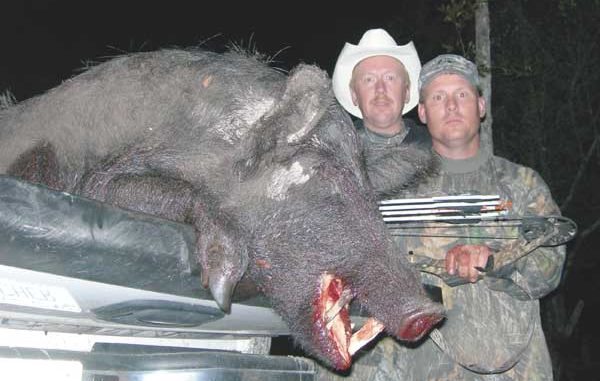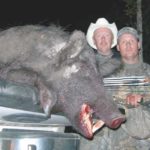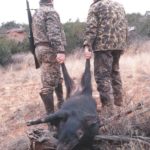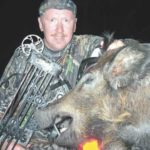
Wild pigs, which have become a nemesis for terrain and wild game, offer an additional challenge to N.C. hunters.
When Hurricane Floyd hit the southeastern coastline and veered north along the East coast Sept. 14-18, 1999, it inflicting its greatest damage in eastern North Carolina.
Floyd produced more human misery and destructive environmental impact in the state than any natural disaster in memory. The 15 to 20 inches of rain that fell across the eastern half of the state flooded every river and stream. National deaths (57) attributed to Floyd stretched from the Carolinas to Maine and damage estimates totaled $6 billion. Many rivers set new flood records after the hurricane that meteorologists dubbed a 500-year storm.
What does Floyd’s effects have to do with N.C. feral hogs? Numerous hog farms were destroyed and an estimated 200,000 hogs drowned. But an unknown number of porkers swam to safety or escaped into the woods and swamps of eastern North Carolina. And they’ve been growing, propagating and making little piglets in the wild ever since.
These feral (wild) pigs also are creating a disaster in the wild that may rival Floyd’s effects, although on a much less visible and slower time frame, according to biologists.
There was a time when places to go hunt feral hogs included South Carolina, Georgia, Florida and other southeastern states, but no longer.
In the past few years, hunters are seeing more wild hogs in counties from one end of North Carolina to the other. In some instances, it’s believed the pigs were released deliberately, and that could be a fact.
Col. Kenneth Everhart, chief of the N.C. Wildlife Resources Commission’s Enforcement Division, has said people have been caught and charged with importing and releasing hogs in the state. That might be a small reason hunters and farmers are seeing more wild hogs, but in reality, Floyd is likely the primary culprit.
Hogs freed by Floyd have had eight years to multiply and spread across the state’s eastern counties.
Either way, it’s a fact feral hogs are found across North Carolina today, especially in the east. Not only that, their numbers are spreading west.
Caswell County of the north-central piedmont and Anson County of the south-central piedmont have healthy populations of feral hogs. Every county between Caswell and Anson and to the east now has complaints about too many feral hogs.
But not everyone is dismayed. Many hunters like having another game species to hunt, although farmers and wildlife biologists aren’t happy.
Hogs are prolific breeders, producing several litters each year of 10 to 15 piglets (or more) in a single litter. Pigs dig and root up almost any plant they can eat and devastate field crops in short order. For biologists, the worry is pigs also compete with deer, turkey and other wildlife for mast crops.
Mack Moore, a hunting guide for “Dirt Road Outfitters,” said wild hogs will eat literally anything. Moore and Scott Kazmierczak operate a guide service in Columbus and Brunswick counties near the Waccamaw River that specializes in bow hunts for feral hogs.
“We’re beginning to see feral hogs at several pieces of private land in Bladen County, and they’re destroying our roads and food plots,” said NCBA member Kyle Bostic of Elizabethtown, “not to mention eating about 200 pounds of corn a day. Tommy White and I are going to have to start hunting them.”
Bostic wanted to know the vital aiming spots of hogs in order to place an arrow for a quick, humane kill.
The N.C. Bowhunters Association created an official category in its record system for feral hogs beginning with 2007. Records chairman, Joey Thompson of King said he anticipated receiving many entries for the new category.
Hogs are officially scored by cleaning and drying the skull for 60 days before scoring by an official measurer. Currently the NCBA record for feral hog is held by Tonnie E. Davis of Roxboro, who arrowed a feral hog in Johnston County in 1999 that officially scored 18 13/16 inches.
Scoring follows the Pope&Young and Boone-and-Crockett methods, measuring the length and width of the skull to the nearest 1/16 inch and adding the two scores. For more information about big-game archery records, go to www.ncbowhunter.com).
The WRC adopted regulations in 2007 addressing specific seasons for wild boar. However, the agency decided it wouldn’t regulate the harvest of wild or feral hogs. Wild boar seasons this past year were Oct.15-Nov. 17 and Dec. 10-Jan. 1 and applied only to six counties in the western section of the state — Cherokee, Clay, Graham, Jackson, Macon and Swain.
Wild swine (classified as wild “boar” in those six counties) had to be harvested during the season dates. However, in the other 94 counties of the state, free-ranging hogs were classified as feral and could be taken any day (or night) of the year (except Sundays) at private lands. Feral hogs also may be taken at game lands, if there is an open season for any game animal at the time.
Anyone hunting at game lands should know the rules governing hunting and baiting on game lands. During archery season, hunting feral pigs can only be done with bow and arrows. In fact, it’s illegal to carry a firearm of any description while bowhunting. Bait also can’t be placed at game lands in order to hunt wild game — including wild pigs.
But the WRC considers feral hogs such a problem, it has no bag limits for them. In fact, the WRC would like to see all feral pigs eliminated. However, individual hunting-guide services may have a daily quota.
Everhart noted wild hogs are nuisances to other wildlife because they destroy turkey nests, eat poults and compete with turkey and deer for natural foods, including insects that turkeys prefer and mast crops such as acorns that sustain deer and turkeys.
Moore hunts all year, mostly for feral hogs, although he and Kazmierczak hunt almost anything and everything that may be in season. They hunt exclusively with bow and arrow but will guide bow or gun hunters during hog hunts.
Moore recently outlined some tips for successfully hunting feral hogs:
• Best time to go: January through March are the best months of the year for hunting feral hogs, although Moore hunts wild pigs all year. He prefers these three months because he’s not bothered by insects and snakes, trees and undergrowth are free of foliage so visibility is better for hunters, and the natural and domestic food supply is almost non-existent, so feral hogs readily will come to feeders.
• Where to aim: Feral hogs have thick hides and their vitals (heart, lungs) are arranged a little differently than deer. With bow and arrow, the only shots to take are broadside and quartering away. Archers never should shoot a hog quartering toward them, facing the hunter or from the rear. A hog’s vitals are smaller and tucked in closer to the shoulders and lower. With a broadside shot, archers should try to place the arrow close to the shoulder and aim a bit lower than for a deer.
• When to hunt hogs: Hogs mostly are nocturnal animals, so best times to hunt are early morning and late evening, but they can be hunted at night.
During a 2006 South African hunt, Greensboro’s Randy Mabe successfully hunted bush pigs at night utilizing a red flood light suspended above a feeding station. That technique may work for feral hogs.
In North Carolina, it’s not illegal to use a light for wild pig hunting at night, but Col. Everhart recommended guides and hunters inform local wildlife enforcement officers prior to night hunting for wild pigs. That way WRC officers will know what’s being done and won’t waste time checking out complaints and interfere with hunts.
Everhart also recommended not using high-powered rifles at night because of safety issues and a law enforcement standpoint. Obviously, a WRC officer who hears nighttime gunshots or receives a complaint may believe he’s investigating an illegal deer poaching situation if not informed.
Hunters also should be careful not to place any baits other than natural substances at areas with open bear seasons.
• Scent control: Hogs have a great sense of smell, probably better than deer. Hunters who you want to be successful should know paying attention to total scent control is an absolute necessity. Older and larger hogs are sensitive to foreign odors.
“One whiff of a human’s presence, and they’ll be gone,” Moore said. “Scent control is essential to a successful hog hunt. Their noses are better than a deer, and they’re smart, smarter than a dog and smarter than many fellows I’ve hunted with, so they’re a formidable quarry.”
• Eyesight: Hogs have poor eyesight, which is compounded because their eyes and scope of vision are at a much lower level than deer. Hogs’ heads are only a couple feet above ground level, and it’s almost impossible for them to look up at a steep angle because their necks are short and stubby. These factors are pluses for tree-stand hunting, which is Moore’s favored technique.
• Hearing: Feral pigs have excellent hearing abilities, similar to deer. If a hunter makes a noise, wild hogs will hear it. Hunters should keep movements to a minimum. When moving, do so carefully and with full concentration to avoid making noise.
• Intelligence: Hogs are intelligent animals. Moore said feral pigs appear to him to be smarter than dogs and a lot smarter than deer. Hunters simply can’t make mistakes and hope to be successful hunting them.
• Scents and attractants: Moore said a variety of commercial scents are available for hunting feral hogs, including “hot sow” and “dominant boar.” Moore said he uses scents frequently and with success.
• Table fare: Feral hogs make for great table fare and some people believe their meat has better flavor than domestic pork. It’s certain wild hog meat contains less fat.
Skinning a wild pig is a more difficult task than skinning a deer. Feral pigs have tough hides that quickly will dull the sharpest skinning knife. Be ready to re-sharpen knives or have a couple of sharpened extra knives on hand when skinning a wild hog.






Be the first to comment